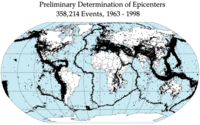
Photo from wikipedia
We built a three-dimensional model to simulate the disturbance of the stress field near the reverse fault in Zhaziao, Leyi Township owing to hydraulic fracturing. The pore pressure, and shear… Click to show full abstract
We built a three-dimensional model to simulate the disturbance of the stress field near the reverse fault in Zhaziao, Leyi Township owing to hydraulic fracturing. The pore pressure, and shear and normal stresses during fracturing are analyzed in detail. Input rock mechanics parameters are taken from laboratory test data of shale samples from the study area. The simulation results suggest that after 16 hours of fluid injection, the pore-pressure variation can activate the reverse fault, i.e., we observe reverse slip, and the shear stress and displacement on the fault plane increase with time. The biggest stress–strain change occurs after one hour of fluid injection and the yield point appears about 0.5 h after injection. To observe the stress evolution in each section, the normal displacement on the boundary is constrained and the fault plane is set as nonpermeable. Thus, the sliding is limited and the shear displacement is only in the scale of millimeters, and the calculated magnitude of the induced earthquakes is between Mw-3.5 and Mw-0.2. The simulation results suggest that fluid water injection results in inhomogeneous fracturing. The main ruptured areas are around the injection positions, whereas the extent of rupturing and cracks in other areas are relatively small. Nevertheless, nonnegligible fault activation is recorded. Sensitivity analysis of the key parameters suggests that the pore pressure is most sensitive to the maximum unbalanced force and the internal friction angle strongly affects the fault slip. Finally, the comparison between the effective normal stress and the maximum and minimum principal stresses on the fault plane explains the fault instability, i.e., the Mohr circle moves towards the left with decreasing radius reduces and intersects the critical slip envelope, and causes the fault to slip.
Journal Title: Applied Geophysics
Year Published: 2018
Link to full text (if available)
Share on Social Media: Sign Up to like & get
recommendations!